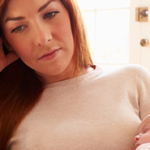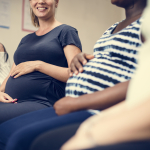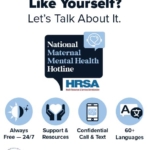The American Academy of Pediatrics (AAP) now recommends that babies sleep in the same room as their mothers. “SIDS and Other Sleep-Related Infant Deaths: Updated 2016 Recommendations for a Safe Infant Sleeping Environment,” was issued in 2016 and is based on new research on sudden unexpected infant death (SUID).
With the goal of reducing the risk of sudden infant death syndrome (SIDS) and other sleep-related infant deaths, the AAP recommends that mothers sleep in the same room with their infant for at least six months and optimally for the first year of the child’s life. These recommendations do not support the practice of bed-sharing and state that infants should sleep on a separate, firm sleep surface — such as a mattress in a safety-approved crib — covered by a fitted sheet with no other bedding or soft objects.
While these recommendations are derived from solid research, they do not take into consideration the well-being and mental health of the mothers. There is research to indicate that room-sharing infants sleep less over the course of the night and have shorter stretches of sleep (Paul et al, 2017). Consequently, room-sharing mothers sleep for less hours and have more night awakenings than mothers with independently sleeping infants.
Sleep disruption, and so often sleep deprivation, are normal experiences for any new mother. Some mothers can deal relatively well with sleep disruption; they have extra help at home, they can nap during the day, or they are simply more resilient to sleep disruptions. But what if you are not one of these mothers? What if you have to take care of other children during the day and don’t have the time to take a nap? What if you have to go to work? What if you don’t have family nearby or the money to hire a babysitter so that you can get some rest? Or what if you have a baby with colic or a baby who is a terrible sleeper?
While it makes sense to promote room-sharing in terms of the infant’s well-being, it is concerning that these recommendations may have unintended consequences for the mother. Poor sleep quality during the postpartum period is a risk factor for postpartum depression and anxiety (Park et al, 2013; Polo-Kantola et al, 2016). We are particularly concerned about how these recommendations may affect women with histories of mood and anxiety disorders who are so vulnerable to recurrent illness during the postpartum period. And for women who do have postpartum depression, can any type of treatment be effective in the setting of prolonged sleep deprivation?
Because sleep disturbance is potentially a risk factor for postpartum depression (PPD), we often recommend that women at risk for PPD make efforts to “protect” their sleep and often suggest that women may sometimes sleep in a different room so that their sleep is not disrupted by the stirrings and awakenings of the baby. Thus our recommendations run counter to the current AAP guidelines. While the AAP recommendations are made to educate new parents and to guide infant care practices, new parents often approach them as ironclad, not-to-be-broken rules. A depressed mother who is not confident in her skills as a parent may not trust her own judgment and may cling to these “rules”. For a mother who is suffering from postpartum anxiety with persistent worries about the infant’s health and safety, these recommendations can feed into a perpetual sense of hypervigilance.
In a study questioning the safety of prolonged room-sharing, Paul and colleagues commented that room-sharing was associated with “poorer sleep-related outcomes and more unsafe sleep practices among dyads who room-share beyond early infancy” and “that the AAP should reconsider and revise the recommendation pending evidence to support room-sharing through the age of 1 year.”
Room-sharing may have its benefits in terms of reducing the risk for SIDS and promoting breastfeeding, this practice may compromise the mother’s well-being. In making recommendations to new parents, we cannot assume that every mother, every baby, and every situation is the same. Guidelines are meant to guide, not to rule, and we must consider each mother, each child, and each situation on an individual basis.
Ruta Nonacs, MD PhD
Volkovich E, Bar-Kalifa E, Meiri G, Tikotzky L. Mother-infant sleep patterns and parental functioning of room-sharing and solitary sleeping families: a longitudinal study from 3 to 18 months. Sleep. 2017 Dec 16.
Paul IM, Hohman EE, Loken E, Savage JS, Anzman-Frasca S, Carper P, Marini ME, Birch LL. Mother-Infant Room-Sharing and Sleep Outcomes in the INSIGHT Study. Pediatrics. 2017 Jul;140(1).








Leave A Comment